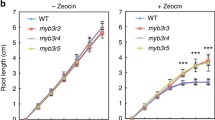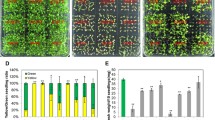Abstract
Thymidine kinase catalyzes the first step in the nucleotide salvage pathway by transferring a phosphate group to a thymidine molecule. In mammals thymidine kinase supplies deoxyribonucleotides for DNA replication and DNA repair, and the expression of the gene is tightly regulated during the cell cycle. Although this gene is phylogenetically conserved in many taxa, its physiological function in plants remains unknown. The genome of the model plant Arabidopsis thaliana has two thymidine kinase genes (AtTK1a and AtTK1b) and microarray data suggest they might have redundant roles. In this study we analyzed the TK1a function by evaluating its expression pattern during development and in response to genotoxic stress. We also studied its role in DNA repair by the characterization of a mutant that contained the T-DNA insertion in the promoter region of the TK1a gene. We found that TK1a is expressed in most tissues during plant development and it was differentially induced by ultraviolet-C radiation because TK1b expression was unaffected. In the mutant, the T-DNA insertion caused a 40 % rise in transcript levels and enzyme activity in Arabidopsis seedlings compared to wild-type plants. This elevation was enough to confer tolerance to ultraviolet-C irradiation in dark conditions, as determined by root growth, and meristem length and structure. TK1a overexpression also provided tolerance to genotoxins that induce double-strand break. Our results suggest that thymidine kinase contributes to several DNA repair pathways by providing deoxythymidine triphosphate that serve as precursors for DNA repair and to balance deoxyribonucleotides pools.






Similar content being viewed by others

References
Adachi S, Minamisawa K, Okushima Y, Inagaki S, Yoshiyama K, Kondou Y, Kaminuma E, Kawashima M, Toyoda T, Matsui M, Kurihara D, Matsunaga S, Umeda M (2011) Programmed induction of endoreduplication by DNA double-strand breaks in Arabidopsis. Proc Natl Acad Sci USA 108:10004–10009
Al-Nabulsi I, Takamiya Y, Voloshin Y, Dritschilo A, Martuza RL, Jorgensen TJ (1994) Expression of thymidine kinase I is essential to low dose radiation resistance of rat glioma cells. Cancer Res 54:5614–5617
Bradford MM (1976) A rapid and sensitive method for the quantitation of microgram quantities of protein utilizing the principle of protein dye binding. Anal Biochem 72:248–254
Bramsiepe J, Wester K, Weinl C, Roodbarkelari F, Kasili R, Larkin J, Hulskamp M, Schnittger A (2010) Endoreplication controls cell fate maintenance. PLoS Genet 6(6):e1000996
Britt A (2002) Repair of damaged bases. The Arabidopsis Book 1:e0005. doi:10.1199/tab.0005
Castroviejo M, Tharaud D, Mocquot B, Litvak S (1979) Factors affecting the onset of deoxyribonucleic acid synthesis during wheat embryo germination. Biochem J 181:193–199
Chabouté ME, Clément B, Philipps G (2002) S phase and meristem-specific expression of the tobacco RNR1b gene is mediated by an E2F element located in the 5′ leader sequence. J Biol Chem 277:17845–17851
Chen I-P, Haehnel U, Altschmied L, Schubert I, Puchta H (2003) The transcriptional response of Arabidopsis to genotoxic stress—a high-density colony array study (HDCA). Plant J 35:771–786
Chen Y-L, Eriksson S, Chang Z (2010) Regulation and functional contribution of thymidine kinase 1 repair of DNA damage. J Biol Chem 285:27327–27335
Clausen AR, Girandon L, Ali A, Knecht W, Rozpedowska E, Sadrini M, Andreasson E, Munch-Petersen B, Piskur J (2012) Two thymidine kinases and one multisubstrate deoxyribonucleoside kinase salvage DNA precursors in Arabidopsis thaliana. FEBS J 279:3889–3896
Clough SJ, Bent AF (1998) Floral dip: a simplified method for Agrobacterium-mediated transformation of Arabidopsis thaliana. Plant J 16:735–743
Culligan KM, Robertson CE, Foreman J, Doerner P, Britt AB (2006) ATR and ATM play both distinct and additive roles in response to ionizing radiation. Plant J 48:947–961
Curtis MJ, Hays JB (2007) Tolerance of dividing cells to replication stress in UVB-irradiated Arabidopsis roots: requirements for DNA translesion polymerases η and ζ. DNA Repair 6:1341–1358
Dobrovolsky VN, Bucci T, Heflich RH, Desjardins J, Richardson FC (2003) Mice deficient for cytosolic thymidine kinase gene develop fatal kidney disease. Mol Gen Metabol 78:1–10
Gasparri F, Wang N, Skog S, Galvani A, Eriksson S (2009) Thymidine kinase 1 expression defines an activated G1 state of the cell cycle as revealed with site-specific antibodies and ArrayScan™ assays. Eur J Cell Biol 88:779–785
Goncalves O, Drobetsky E, Meuth M (1984) Structural alteration of the aprt locus induced by deoxyribonucleoside triphosphate pool imbalances in Chinese hamster ovary cells. Mol Cell Biol 4:1792–1799
Halliday KJ, Hudson M, Ni M, Qin M, Quail PH (1999) poc1: an Arabidopsis mutant perturbed in phytochrome signaling because of a T-DNA insertion in the promoter of PIF3, a gene encoding phytochrome-interacting bHLH protein. Proc Natl Acad Sci USA 96:5832–5837
Hays JB (2002) Arabidopsis thaliana, a versatile model system for study of eukaryotic genome-maintenance functions. DNA Repair 1:579–600
Hill TA, Day CD, Zondlo SC, Thackeray AG, Irish VF (1998) Discrete spatial and temporal cis-acting elements regulate transcription of the Arabidopsis floral homeotic gen APETALA3. Development 125:1711–1721
Holdenrieder S, Von Pawel J, Duell T, Feldmann K, Raith H, Schollen A, Nagel D, Stieber P (2010) Diagnosis, therapy monitoring and prognosis of non-operable lung cancer. Anticancer Res 30:1855–1862
Hruz T, Laule O, Szabo G, Wessendorp F, Bleuler S, Oertle L, Widmayer P, Gruissem W, Zimmermann P (2008) Genevestigator V3: a reference expression database for the meta-analysis of transcriptomes. Adv Bioinform 1–5. Article ID 420747
Jefferson RA, Kavanagh TA, Bevan MW (1987) GUS fusions: β-glucuronidase as a sensitive and versatile gene fusion marker in higher plants. EMBO J 6:3901–3907
Jiang K, Feldman LJ (2005) Regulation of root apical meristem development. Annu Rev Cell Dev Biol 21:485–509
Kafer C, Zhou L, Santoso D, Guirgis A, Weers B, Park S, Thornburg R (2004) Regulation of pyrimidine metabolism in plants. Front Biosci 9:1611–1625
Kimura S, Tahira Y, Ishibashi T, Mori Y, Mori T, Hashimoto J, Sakaguchi K (2004) DNA repair in higher plants; photoreactivation is the major DNA repair pathway in non-proliferating cells while excision repair (nucleotide excision repair and base excision repair) is active in proliferating cells. Nucleic Acid Res 32:2760–2767
Kunz BA, Kohalmi SE, Kunkel TA, Mathews CK, McIntosh EM, Reidy JA (1994) Deoxyribonucleotides triphosphate levels: a critical factor in the maintenance of genetic stability. Mutat Res Rev 318:1–64
Livak KJ, Schmittgen TD (2001) Analysis of relative gene expression data using real-time quantitative PCR and the 2−ΔΔCt method. Methods 25:402–408
Mainguet S, Gakiere B, Majira A, Pelletier S, Bringel F, Guerard F, Caboche M, Berthomé R, Renou JP (2009) Uracil salvage is necessary for early Arabidopsis development. Plant J 60:280–291
McKenna PG, Hickey I (1981) UV sensitivity in thymidine kinase deficient mouse erythroleukaemia cells. Cell Biol Int Rep 5:555–561
McKenna PG, McKelvey VJ, Frew TL (1988) Sensitivity to cell killing and the induction of cytogenetic damage following gamma irradiation in wild-type and thymidine kinase-deficient Friend mouse erythroleukaemia cells. Mutat Res 200:231–242
Moffatt BA, Ashihara H (2002) Purine and pyrimidine nucleotide synthesis and metabolism. The Arabidopsis Book 1:e0018. doi:10.1199/tab.0018
Munch-Petersen B (2009) Reversible tetramerization of human TK1 to the high catalytic efficient form is induced by pyrophosphate, in addition to tripolyphosphates, or high enzyme concentration. FEBS J 276:571–580
Mutahir Z, Balle Larsen N, Slot Christiansen L, Andersson K-M, Rico R, Mebrahtu Wisen S, Clausen AR, Munch-Petersen B, Piskur J (2011) Characterization of oligomeric and kinetic properties of tomato thymidine kinase 1. Nucleosides Nucleotides Nucleic Acids 30:1223–1226
Nisman B, Allweis T, Kaduri L, Maly B, Gronowitz S, Hamburger T, Peretz T (2010) Serum thymidine kinase 1 activity in breast cancer. Cancer Biomark 7:65–72
O’Neill KL, Buckwalter MR, Murray BK (2001) Thymidine kinase: diagnostic and prognostic potential. Expert Rev Mol Diagn 1:428–433
Ramirez-Parra E, Frundt C, Gutierrez C (2003) A genome-wide identification of E2F-regulated genes in Arabidopsis. Plant J 33:801–811
Ricaud L, Proux C, Renou J-P, Pichon O, Fochesato S, Ortet P, Montané M-H (2007) ATM-mediated transcriptional and developmental response to X-rays in Arabidopsis. PLoS One 2:e430
Roldán-Arjona T, Ariza RR (2009) Repair and tolerance of oxidative DNA damage in plants. Mutation Res 681:169–179
Rotheneder H, Geymayer S, Haidweger E (1999) Transcription factors of the Sp1 family: interaction with E2F and regulation of the murine thymidine kinase promoter. J Mol Biol 293:1005–1015
Santiago MJ, Ruiz Rubio M, Di Dio L, González-Reyes JA, Alejandre-Durán E (2008) Ubiquitous expression of two translesion synthesis DNA polymerase genes in Arabidopsis. Planta 227:1277–1285
Stasolla C, Katahira R, Thorpe TA, Ashihara H (2003) Purine and pyrimidine nucleotide metabolism in higher plants. J Plant Physiol 160:1271–1295
Tuteja N, Ahmad P, Panda BB, Tuteja R (2009) Genotoxic stress in plants: shedding light on DNA damage, repair and DNA repair helicases. Mutat Res Rev 681:134–149
Ullah HM, Robertson D, Fites RC (1999) A gene for thymidine kinase in plants. Plant Physiol 119:1567–1568
Vandepoele K, Vlieghe K, Florquin K, Henning L, Beemster GTS, Gruissem W, Van de Peer Y, Inze D, De Veylder L (2005) Genome-wide identification of potential plant E2F target genes. Plant Physiol 139:316–328
Venkatachalam P, Geetha N, Priya P (2010) Identification of a differentially expressed thymidine kinase gene related to tapping panel dryness syndrome in the rubber tree (Hevea brasiliensis Muell. Arg.) by random amplified polymorphic DNA screening. Int. J Plant Biol 1(e7):33–39
Wolcott RM, Colacino JM (1989) Detection of thymidine kinase activity using an assay based on the precipitation of nucleoside monophosphates with lanthanum chloride. Anal Biochem 178:38–40
Yadav RK, Girke T, Pasala S, Xie M, Reddy GV (2009) Gene expression map of the Arabidopsis shoot apical meristem stem cell niche. Proc Natl Acad Sci USA 106:4941–4946
Yi D, Kamei CLA, Cools T, Vanderauwera S, Takahashi N, Okushima Y, Eekhout T, Yoshiyama KO, Larkin J, Van den Daele H, Conklin P, Britt A, Umeda M, De Veylder L (2014) The Arabidopsis SIAMESE-RELATED cyclin-dependent kinase inhibitors SMR5 and SMR7 regulate the DNA damage checkpoint in response to oxygen species. Plant Cell 26:296–309
Yoshiyama K, Conklin PA, Huefner ND, Britt AB (2009) Suppressor of gamma response 1 (SOG1) encodes a putative transcription factor governing multiple responses to DNA damage. Proc Natl Acad Sci USA 106:12843–12848
Yoshiyama KO, Kobayashi J, Ogita N, Ueda M, Kimura S, Maki H, Umeda M (2013) ATM-mediated phosphorylation of SOG1 is essential for the DNA damage response in Arabidopsis. EMBO Rep 14:817–822
Yoshiyama KO, Kimura S, Maki H, Britt AB, Umeda M (2014) The role of SOG1, a plant-specific transcriptional regulator, in the DNA damage response. Plant Signal Behav 9:e28889
Zrenner R, Stitt M, Sonnewald U, Boldt R (2006) Pyrimidine and purine biosynthesis and degradation in plants. Annu Rev Plant Biol 57:805–836
Acknowledgments
This study was funded by the project IN220010 from the Dirección General de Asuntos de Personal Académico, Programa Apoyo a Proyectos de Investigación e Innovación Tecnológica (DGAPA-PAPIIT), from Universidad Nacional Autónoma de México. The authors gratefully acknowledge the technical assistance of Laurel Fabila-Ibarra for greenhouse work and from Dr. Carolina Peña-Montes for her help in setting-up qRT-PCR experiments. We thank Dr. A. C. Chávez-Mejía (Instituto de Ingeniería, UNAM) for the use of the UV-radiometer. JAPG received a fellowship (#323244) to pursue a M.Sc. degree from Consejo Nacional de Ciencia y Tecnología (CONACYT).
Author information
Authors and Affiliations
Corresponding author
Electronic supplementary material
Below is the link to the electronic supplementary material.
Rights and permissions
About this article
Cite this article
Pedroza-García, J.A., Nájera-Martínez, M., de la Paz Sanchez, M. et al. Arabidopsis thaliana thymidine kinase 1a is ubiquitously expressed during development and contributes to confer tolerance to genotoxic stress. Plant Mol Biol 87, 303–315 (2015). https://doi.org/10.1007/s11103-014-0277-7
Received:
Accepted:
Published:
Issue Date:
DOI: https://doi.org/10.1007/s11103-014-0277-7



